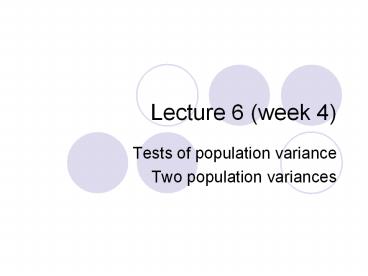Lecture 6 (week 4) - PowerPoint PPT Presentation
Title:
Lecture 6 (week 4)
Description:
Lecture 6 (week 4) Tests of population variance Two population variances – PowerPoint PPT presentation
Number of Views:159
Avg rating:3.0/5.0
Title: Lecture 6 (week 4)
1
Lecture 6 (week 4)
- Tests of population variance
- Two population variances
2
Section7.3 Inference for variances
- Inference for population spread
- The F test for equality of variance
- The power of the two sample t-test
3
Inference for population spread
- It is possible to compare two population standard
deviations s1 and s2 by comparing the standard
deviations of two SRSs. However, these procedures
are not robust at all against deviations from
normality. - When s12 and s22 are sample variances from
independent SRSs of sizes n1 and n2 drawn from
normal populations, the F statistic - F s12 / s22
- has the F distribution with n1 - 1 and n2 - 1
degrees of freedom when H0 s1 s2 is true.
4
- The F distributions are right-skewed and cannot
take negative values. - The peak of the F density curve is near 1 when
both population standard deviations are equal. - Values of F far from 1 in either direction
provide evidence against the hypothesis of equal
standard deviations. - Table E in the back of the book gives critical
F-values for upper p of 0.10, 0.05, 0.025, 0.01,
and 0.001. We compare the F statistic calculated
from our data set with these critical values for
a one-side alternative the p-value is doubled
for a two-sided alternative.
5
Table E
6
Does parental smoking damage the lungs of
children? Forced vital capacity (FVC) was
obtained for a sample of children not exposed to
parental smoking and a group of children exposed
to parental smoking.
Parental smoking FVC s n
Yes 75.5 9.3 30
No 88.2 15.1 30
H0 s2smoke s2no Ha s2smoke ? s2no (two
sided)
The degrees of freedom are 29 and 29, which can
be rounded to the closest values in Table E 30
for the numerator and 25 for the denominator.
2.54 lt F(30,25) 2.64 lt 3.52 ? 0.01 gt 1-sided p
gt 0.001 ?0.02 gt 2-sided p gt 0.002
7
Power of the two-sample t-test
- The power of the two-sample t-test against a
specific alternative value of the difference in
population means (µ1 - µ2) assuming a fixed
significance level a is the probability that the
test will reject the null hypothesis when the
alternative is true. - The basic concept is similar to that for the
one-sample t-test. The exact method involves the
noncentral t distribution. Calculations are
carried out with software. - You need information from a pilot study or
previous research to calculate an expected power
for your t-test and this allows you to plan your
study smartly.
8
Power calculations using a noncentral t
distribution
- For the pooled two-sample t-test, with parameters
µ1, µ2, and the common standard deviation s we
need to specify - An alternative that would be important to detect
(i.e., a value for µ1 - µ2) - The sample sizes, n1 and n2
- The Type I error for a fixed significance level,
a - A guess for the standard deviation s
- We find the degrees of freedom df n1 n2 - 2
and the value of t that will lead to rejection
of H0 µ1 - µ2 0 - Then we calculate the noncentrality parameter d
9
- Finally, we find the power as the probability
that a noncentral t random variable with degrees
of freedom df and noncentrality parameter d will
be greater than t - In R this is 1-pt(tstar, df, delta). There are
also several free online tools that calculate
power. - Without access to software, we can approximate
the power as the probability that a standard
normal random variable is greater than t - d,
that is, P(z gt t - d), and use Table A. - For a test with unequal variances we can simply
use the conservative degrees of freedom, but we
need to guess both standard deviations and
combine them for the guessed standard error
10
Online tools
11
(No Transcript)































